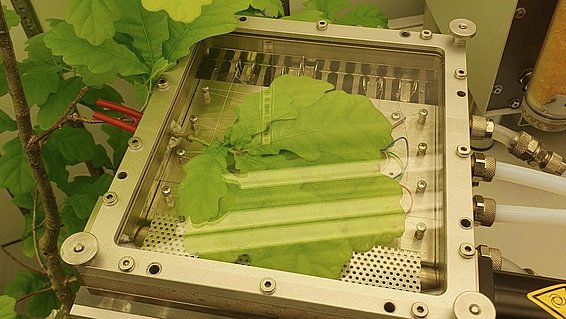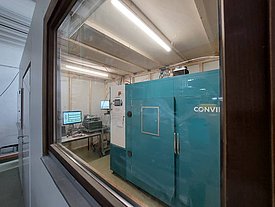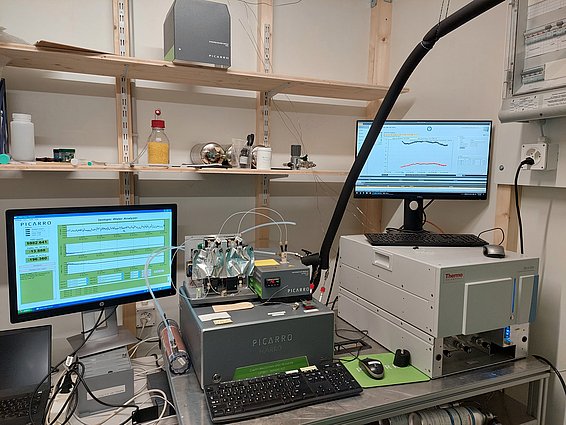13.05.2024 | Andreas Bättig | WSL News
At temperatures above 30°C, water loss through transpiration increases in trees, while CO₂ uptake decreases – even when there is enough CO₂ in the atmosphere. Researchers at the Swiss Federal Institute for Forest, Snow and Landscape Research WSL were able to show this in a study conducted using a new high-tech facility. This finding is important for understanding how trees adapt to climate change and the associated rise in temperatures.

Climate change is leading to an increasing exposure of plants to high temperatures. WSL researchers have examined how trees adapt to extreme temperatures under experimental conditions. In all species studied, they found that CO₂ uptake, which allows plants to produce sugar from sunlight during photosynthesis, decreases above 30°C, while water loss through transpiration continues to increase. A novel experimental facility called XiBox (see inset) has enabled the scientists to maintain water vapor pressure deficit (VPD) at a constant level while gradually increasing temperature.
Limitations in the biochemistry of trees ¶

It is noteworthy that CO₂ uptake is reduced even when there is actually enough CO₂ in the air and in the leaves. «We were able to rule out that the decrease in CO₂ absorption at high temperatures is due to reduced CO₂ availability. This suggests a limitation in the biochemistry of trees at around 30°C,» says study leader Marco Lehmann. This limitation appears to be due to an alteration of the enzymatic processes of photosynthesis, according to the researcher. At the same time, the plant loses proportionally a lot of water compared to the amount of CO₂ absorbed. «In summary, we can say that heat leads to a very inefficient photosynthesis,» explains Lehmann. Inefficient photosynthesis over a long period of time can severely impair the growth, development and adaptability of trees (or plants) and ultimately affect the entire forest ecosystem.
The scientists examined the following tree species: beech (Fagus sylvatica), spruce (Picea abies), sessile oak (Quercus petraea) and small-leaf lime (Tilia cordata). «All the trees reacted in the same way. There were no significant differences between species», adds Lehmann.
Understanding the impact of climate change ¶

Using the XiBox, scientists were able to expose plants to different environmental conditions under controlled conditions and monitor their behavior through gas exchange and isotope measurements. Isotopes are naturally occurring atom variants of the same element with different masses. Carbon, for example, contains both light and heavy variants of atoms. The ratio between light and heavy isotopes changes when CO₂ is absorbed by the plant. «Studying the effects of temperature and humidity on tree-atmosphere gas exchange independently poses a significant challenge, owing to the intricate between these two climatic factors,» comments Lehmann.
«The experiments were technically very complex. In the XiBox, we can carry out experiments and simulate environmental conditions that are hardly feasible in this form under natural conditions», he continues. According to him, such simulations are important for better understanding and predicting the ability of plants and their functions to adapt to new climatic conditions and the resulting rise in temperatures.
High-tech equipment for forest research
Simulating the effects of extreme climate conditions experimentally is often difficult, but is absolutely essential for research in order to better understand how our forests will react to the warmer and sometimes drier climate of the future.
To improve the potential for forest research, a new type of experimental research facility has been set up at WSL in recent years: the Experimental Box for high-resolution plant gas-exchange and isotope research under extreme conditions, or XiBox.
The heart of the XiBox is an approximately two-square-meter climate chamber that allows the scientists to grow various plant species (e.g. young trees, herbaceous plants, grasses) under different combinations of light, relative humidity and temperature conditions. What is innovative is that plant cultivation and treatment can be carried out under optimum light conditions and under temperature conditions of up to 40°C. The XiBox is equipped with modern high-precision gas exchange meters for the measurement of CO₂ and water fluxes, as well as laser spectrometers for the analysis of carbon, oxygen and hydrogen isotope ratios in CO₂ and water. Fluxes and isotopes can be measured simultaneously using a valve switching system. This makes it possible to observe plant reactions to environmental conditions in real time. The XiBox is also equipped with electricity, water, internet, measurement gases, and an air conditioning system.
Further information about the XiBox
Vapor pressure deficit (VPD) is one of the most important factors influencing plant transpiration. What it is and why its increase has attracted the attention of ecophysiologists in recent years is explained here.
VPD in the climate equation and its impact on vegetation
Contact ¶
Publication ¶
Diao, H., Cernusak, L. A., Saurer, M., Gessler, A., Siegwolf, R. T. W., & Lehmann, M. M. (2024). Uncoupling of stomatal conductance and photosynthesis at high temperatures: mechanistic insights from online stable isotope techniques. New Phytologist, 241(6), 2366-2378. https://doi.org/10.1111/nph.19558
Newsletter ¶
Always up to date: Subscribe to the WSL Newsletter.
Copyright ¶
WSL and SLF provide image and sound material free of charge for use in the context of press contributions in connection with this media release. The transfer of this material to image, sound and/or video databases and the sale of the material by third parties are not permitted.
